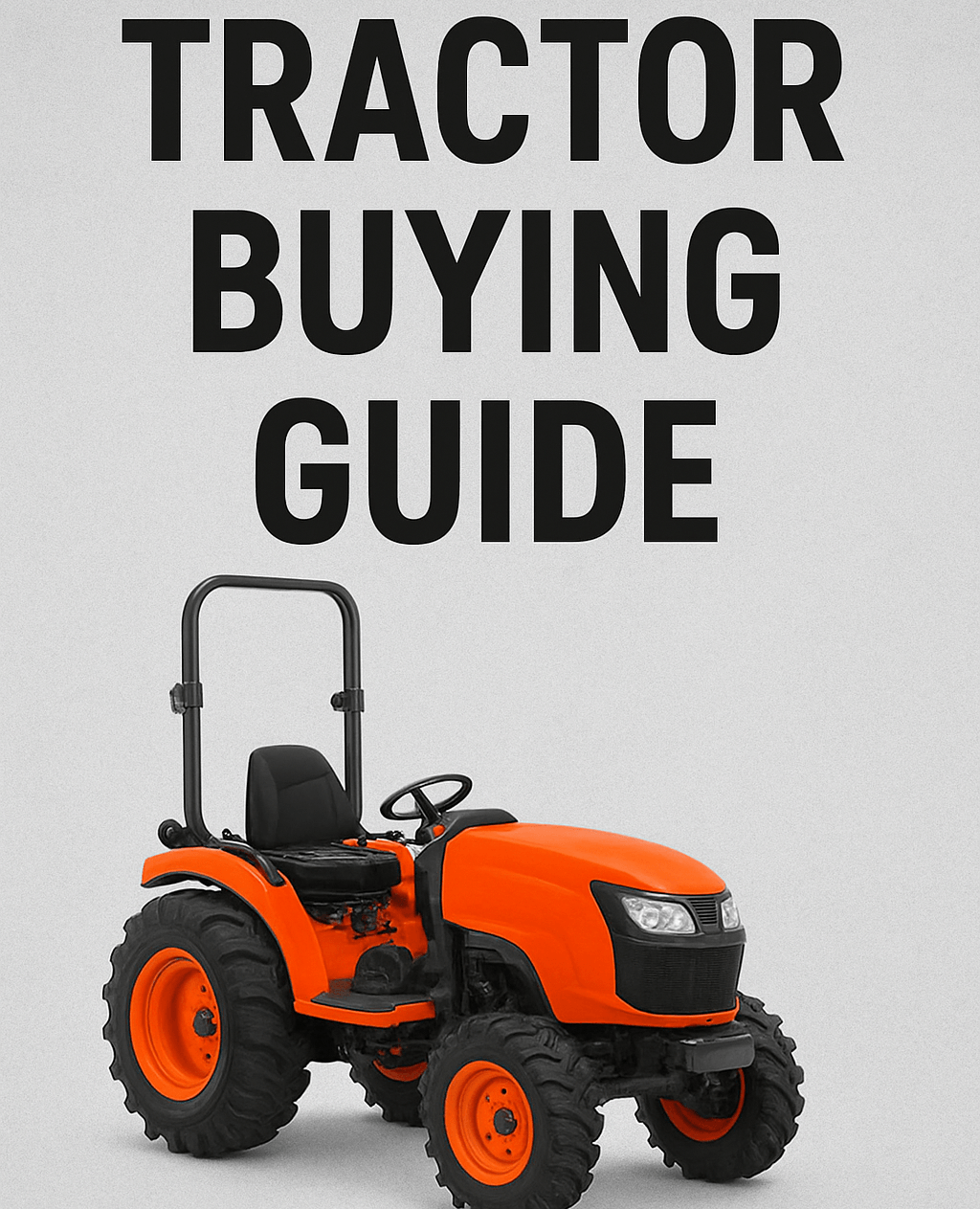That sinking feeling when you realize you bought the wrong tractor is something no farmer should experience. I’ve watched too many people make expensive mistakes like the rancher who bought a massive 100 HP tractor for his 10-acre property, or the homeowner who thought a sub-compact could handle 50 acres of rough terrain. These costly errors could have been avoided with a proper tractor buying guide.
Choosing the right tractor isn’t about finding the biggest, shiniest, or cheapest machine. It’s about matching equipment to your specific needs, budget, and future plans. After helping hundreds of buyers navigate this process, I’ve developed a straightforward approach that takes the guesswork out of tractor selection.
Whether you’re a first-time buyer or adding to your equipment fleet, this comprehensive tractor buying guide will help you make an informed decision that you won’t regret years later.
Discover more farming resources

Step 1: Honestly Assess Your Needs
Understand Your Property and Tasks
Before looking at any tractors, grab a notebook and document:
Property Details:
- Total acreage and terrain type
- Building and gate measurements
- Storage availability
- Future expansion plans
Task Requirements:
- Primary uses (mowing, tilling, loading, etc.)
- Frequency of each task
- Seasonal variations
- Help from other equipment
The USDA Natural Resources Conservation Service offers excellent property assessment tools that can help you understand your land’s specific requirements.
The 5-Year Test
Ask yourself: “What will I need this tractor to do in five years?” Many buyers focus only on current needs, but your tractor buying guide should account for growth. If you plan to expand your operation, buy for future needs rather than current ones.
Step 2: Set Your Budget Realistically
Total Cost of Ownership
Your tractor buying guide budget should include:
Initial Costs:
- Tractor base price
- Essential implements
- Delivery and setup
- Sales tax
Ongoing Costs:
- Insurance ($400-800/year)
- Maintenance ($500-1,200/year)
- Fuel ($1,000-3,000/year)
- Storage ($0-2,000/year)
Hidden Costs:
- Implement repairs
- Downtime losses
- Learning curve inefficiencies
Financing Considerations
According to the Equipment Leasing and Finance Association, smart financing can save you thousands:
Loan Terms: 3-7 years typically
Interest Rates: Vary by credit and lender
Down Payment: 10-20% standard
Tax Benefits: Section 179 deductions available
Step 3: Understand Tractor Types and Sizes
Sub-Compact Tractors (18-25 HP)
Best For:
- Properties under 5 acres
- Light landscaping
- Small gardens
- Limited budgets
Limitations:
- Limited implement capacity
- Not for heavy work
- Slower operation
Compact Tractors (25-60 HP)
Best For:
- 5-50 acre properties
- Diverse tasks
- Small farming
- Landscaping businesses
Advantages:
- Good power-to-size ratio
- Extensive implement options
- Great versatility
Utility Tractors (60-140 HP)
Best For:
- Large properties
- Commercial farming
- Heavy construction
- Large-scale operations
Considerations:
- Higher operating costs
- More storage space needed
- Requires experience to operate safely
Step 4: Evaluate Key Features
Power and Performance
Your tractor buying guide should prioritize:
Engine Power:
- Match HP to your heaviest task
- Consider PTO requirements
- Factor in altitude if applicable
Hydraulic System:
- Flow rate (GPM) for implements
- Number of remotes needed
- Loader capacity requirements
Transmission Options
Manual Transmission:
- Lower cost
- Better fuel efficiency
- Requires more skill
Hydrostatic Transmission:
- Easier operation
- Better for loader work
- Higher maintenance costs
PowerShift Transmission:
- Professional grade
- Excellent productivity
- Highest cost
Step 5: Consider Implements and Attachments
Essential Starter Implements
Your tractor buying guide should include:
Loader: For material handling
Box Blade: For grading and leveling
Rotary Cutter: For brush management
Post Hole Digger: For fencing
Implement Compatibility
Check:
- Three-point hitch category
- PTO requirements
- Hydraulic needs
- Weight limitations
The American Society of Agricultural and Biological Engineers sets standards that ensure implement compatibility across brands.
Step 6: Research Brands and Dealers
Brand Considerations
Established Brands:
- Better resale value
- Strong dealer networks
- Proven reliability
Value Brands:
- Lower initial cost
- Improving quality
- Growing dealer networks
Dealer Evaluation
Your tractor buying guide must include dealer assessment:
Service Department:
- Technician qualifications
- Parts availability
- Response time
Support Services:
- Delivery options
- Operator training
- Warranty handling
Step 7: The Test Drive Checklist
Comfort and Usability
- Enter/exit ease
- Control layout
- Visibility
- Seat comfort
Performance Testing
- Loader operation
- Transmission smoothness
- Hydraulic response
- Turning radius
Step 8: Understand the Purchase Process
Negotiation Tips
- Research fair market prices
- Consider package deals
- Ask for implements included
- Negotiate delivery and setup
Final Checklist
Before signing:
- Review warranty terms
- Understand service requirements
- Get all promises in writing
- Verify financing terms
Common Mistakes to Avoid
The “Too Much Tractor” Error
Buying more machine than you need leads to:
- Wasted money
- Storage issues
- Higher operating costs
- Difficulty maneuvering
The “Too Little Tractor” Mistake
An underpowered tractor causes:
- Constant strain on equipment
- Inability to complete tasks
- Frequent repairs
- Premature replacement
The Bottom Line: Smart Tractor Selection
Choosing the right tractor requires honest self-assessment, thorough research, and careful planning. This tractor buying guide provides the framework, but your specific situation will determine the best choice.
Remember that the perfect tractor is the one that disappears into your workflow—becoming an invisible partner rather than a constant source of attention or frustration. Take your time, ask questions, and don’t rush the decision.
The most successful tractor owners I’ve worked with aren’t those who found the “best” tractor, but those who found the right tractor for their specific needs and circumstances.
Ready to Find Your Perfect Tractor?
Our equipment specialists can help you navigate every step of the selection process with personalized advice based on your specific needs.
Schedule a consultation to get expert guidance on your tractor purchase.
Book Your Tractor Consultation
Need help comparing options? Browse our inventory with transparent pricing and detailed specifications.